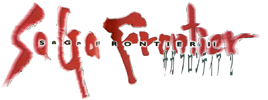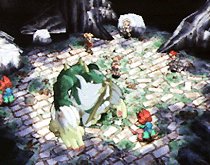|
|

|
PLATFORM
|
PS1
|
BATTLE SYSTEM
|

|
INTERACTION
|

|
ORIGINALITY
|

|
STORY
|

|
MUSIC & SOUND
|

|
VISUALS
|

|
CHALLENGE
|
Hard
|
COMPLETION TIME
|
20-40 Hours
|
|
OVERALL

|
+ Beautiful Graphics
+ Battle System
+ Level of Depth
- Big Learning Curve
- Two extremely difficult scenarios
- Disjointed Story
|
Click here for scoring definitions
|
|
|
The SaGa games have always been in the shadow of series like Final Fantasy and Dragon Quest but have retained a moderately sized group of hardcore fans along the way. I say the word hardcore because the learning curve of these games is fairly high; even to veteran RPG players the mechanics can seem strange and counter-intuitive. Everything you’ve learned from playing standard RPG’s has to be thrown out the window, which is more easily said than done. This feeling is also not helped by the fact that many core mechanics of the game are simply not explained, and some things that turn out to be crucial (like Roles) can be easily missed out on. But if you can get over that hump you will discover a very deep and enjoyable set of gameplay mechanics. These mechanics are pretty much the same in every SaGa game, but SaGa Frontier 2 changes one important element (which I think ultimately cripples the game): it does away with the ‘free scenario system’. In previous games you could select between 7 or 8 characters and complete their individual quest lines; but at the same time the world was your oyster. You could go anywhere and do anything - it was a very liberating and sometimes frustrating feeling as very often you had little direction for where to go or what to do next. But that sandbox style was replaced by a timeline scenario system. There are two main characters whose individual storylines unfold concurrently in the games history. You select a scenario at some point in the timeline, complete it, and the next chronological one opens up. The story in all spans over 2 generations of families, so at the beginning of the game you will be playing one character and by the end you might be playing that characters grandchild.
This gives the game a lot more direction than previous SaGa titles did (which might be welcomed by some gamers), but it does so at the cost of freedom. Once a scenario in the timeline is completed you cannot go back to it – sometimes for good. So if there was a piece of equipment you wanted to buy or a dungeon you wanted to revisit you were out of luck. This type of storytelling might be good for a gameplay system that was designed for it, but it feels very out of place in a SaGa game. The mechanics of the series were based around the idea that you had complete freedom, so when you try to take those mechanics and force them to fit with a restrictive game world you get some very odd outcomes. For example, everytime you use a weapon or item in battle it degrades it – and after a while the item will permanently break unless you repair it. But repairing items is very expensive and often not worthwhile (especially early in the game where currency is hard to come by). You add that to a game with a very non-intuitive and complex battle system and you can find yourself in a scenario with broken weapons and not enough money to buy new ones (if the shop even carries that kind). SaGa ‘s mechanics were built with an eye towards experimentation and reiteration: sparking new arts, trying to find art-combos while in group, determining which abilities work well in certain situations and not others, ect. All of this is damaged by the fact that you cannot indefinitely experiment like in previous games. Only towards the end of the game are you in a position to freely skill up your party without having to worry about breaking items or running out of money. Making basic weapon and Anima types not degrade is what should have been done to accommodate the new storytelling technique.
 One of the many beautiful vistas
One of the many beautiful vistas
|
|
Fortunately these mistakes cannot fully dismantle SaGa Frontier’s battle system. Learning new arts, discovering game changing combos, and seeing things skill up after every battle can be more rewarding than receiving the standardized experience points. These things are also crucial to the gameplay, you can be stuck on a particular boss and just by learning one new combo you can turn the tide in your favor. That’s because the relative damage between different skills and combos is many orders of magnitude higher than in most RPG’s. Once again you need to unlearn the standard RPG orthodoxies in order to succeed. In addition to normal group battles a lot of the time you have the option of dueling an enemy. The purpose of this is not very apparent at first but after a while you’ll notice it’s a much faster way of sparking new skills. You have a plethora of different actions (such as basic attack, large attack, focus, charge, ect.) and you can input four of them per turn. Each one you select will guide you to other actions in order to form combination attacks and spells. Experimenting with this system is part of the fun, sometimes you’ll discover something useless and other times a new devastating art. A new and crucial feature added to Saga Frontier 2 is being able to equip any character with an art learned by another character. This was a necessary change since you switch party members so often, but this constant switching can become an annoyance because all the statistical advancements you made on your characters are gone. The arbitrary rearranging of characters makes it all seem pointless until you get to the final party members. The game does not let you see this coming either, there are no hints of when a big timeline change is about to happen. One minute you’ll be fighting with your regular group and the next minute you will be playing an entirely new batch of characters with half the hp and weapon stats as your previous one. Any sense of advancement is completely killed by this, and can leave you feeling demoralized at the prospect of skilling up yet again.
The designers also took some liberty with the visuals of the game. But where they failed with the storytelling they shined in this department. SaGa Frontier 2 is simply beautiful to look at, sometimes you just want to stop and absorb the scenery around you. A snapshot of this game could literally be hung on the wall with other works of art, they are that good. It’s a perfect mix of watercolors, hand-drawn backgrounds, and sprite-based characters. It showed that 2D was alive and well and you didn’t need clunky 3D graphics to amaze someone visually. I’ve always thought that PS1 RPG’s always looked better in 2D, and it wasn’t until 2 generations of consoles later could you finally have 3D textures that were as high res as pre-rendered backgrounds. The integration of the sprite characters was done much better this time as well, in the first SaGa Frontier the characters seemed disconnected from the environment and it was much harder to know where you could and could not go. There is the occasional problem in this game of determining what is foreground or background, but most of time it’s not an issue. The general aesthetics of the game are pleasing and it mostly makes up for its shortcomings.
 Bosses are generally obese
Bosses are generally obese
|
|
Another one of those shortcomings is the story. The timeline scenarios are hit and miss; there is the occasional one that makes you think it could be going somewhere interesting but they often lead to dead ends. Most of the time you will be reading incoherent text that borderlines on parody - almost like you’re reading the cliff notes version of a Shakespeare play. Characters will literally say what they are feeling with no metaphors in sight. That can be generalized for the pace of the story as well, at one point one of the characters is able to overthrow a king overnight and take his place. The background and reasons for this event goes untold and leaves you thinking “wait…what?”. There are a few isolated stories that do leave you wanting more, but there is much more of the former than the latter. The sound and music are average for the most part, there are a couple stand-out tracks and I didn’t find any of the sound effects to be annoying. Other than that there really isn’t anything worth mentioning; it’s your standard Squaresoft type soundtrack.
The difficulty of this game is extremely erratic. In a single area you will find enemies that can barely touch you and some that will one-shot your entire party; I am not exaggerating. This makes the Quicksave feature an essential part of the game and something I wish other RPG’s would add. It allows you to save your game to the Playstation’s internal RAM; which is instantaneous. So having your party wiped out is not a huge deal (and believe me it will happen often) as your saved state can be loaded in seconds. You learn which enemies to avoid and which to engage; the tougher enemies can be taken on later and give you a better chance of learning new arts. The only enemies which seem to progress logically are the bosses; they usually are a good gauge of where you should be. I should add that there are two extremely difficult parts of the game near the end. One is the final strategy battle which is nothing but pure luck. Even if you make the perfect moves you still have maybe a one in ten chance of succeeding. It will induce controller throwing even to people with mild manners, so be warned. The other difficult part is the final boss of the game, The Egg (you’ll just have to play through to understand), which wouldn’t be so bad if you weren’t permanently stuck in the final dungeon. Make sure you have a saved game slot that is prior to entering the northern continent because if your party isn’t up to snuff you will have to start the game over from scratch – I’m not kidding.
This game is an odd mix of bad design decisions, beautiful graphics, disorganized storytelling, complicated gameplay mechanics, and a fun battle system. So is the game worth playing? Well if you’ve read this far you probably know if you’re the sort of person who will enjoy it or not. It’s definitely not for everyone and will often times leave you scratching your head; but there is a good game buried beneath its strange exterior.
Review Archives
|









